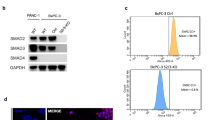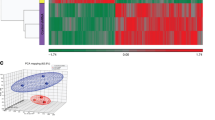Abstract
The transforming growth factor-β (TGF-β)-Smad signaling pathway inhibits the growth of human epithelial cells and plays a role in tumor suppression. The Smad4 gene is mutated or deleted in 50% of pancreatic cancers. In this study, we succeeded in establishing Smad4 knockdown (S4KD) pancreatic cancer cell lines using the stable RNA interference (RNAi) method. Smad4 protein expression was reduced dramatically and TGF-β-Smad signaling was markedly inhibited in the S4KD cell lines. The S4KD and control cells were stimulated with TGF-β and analysed using a cDNA microarray that contained 3756 genes, in order to screen for target molecules downstream of TGF-β. The microarray analysis revealed that 187 S4KD genes and 155 genes in the control cells were regulated immediately upon TGF-β stimulation. Quantitative RT–PCR analysis on several of these genes produced results that corroborated the outcome of the microarray analysis. Most of the genes in the S4KD and control cells identified by the array differed, which suggests signaling pathways that differ according to Smad4 status. Of the identified genes, 246 have not been reported previously as genes that lie downstream of TGF-β. Genes that are involved in cell proliferation, adhesion, and motility were found to be regulated differentially with respect to S4KD and control cells. Cell migration induced by TGF-β was inhibited in the S4KD cells, which might be associated with a different regulation of integrin β7. The knock down of a specific gene using stable RNAi appears to be a promising tool for analysing endogenous gene function.
This is a preview of subscription content, access via your institution
Access options
Subscribe to this journal
Receive 50 print issues and online access
$259.00 per year
only $5.18 per issue
Buy this article
- Purchase on Springer Link
- Instant access to full article PDF
Prices may be subject to local taxes which are calculated during checkout








Similar content being viewed by others
References
Akiyoshi S, Ishii M, Nemoto N, Kawabata M, Aburatani H and Miyazono K . (2001). Jpn. J. Cancer Res., 92, 257–268.
Bhowmick NA, Ghiassi M, Bakin A, Aakre M, Lundquist CA, Engel ME, Arteaga CL and Moses HL . (2001). Mol. Cell Biol., 12, 27–36.
Brummelkamp TR, Bernards R and Agami R . (2002). Science, 296, 550–553.
Chen G, Gharib TG, Huang C-C, Taylor JMG, Misek DE, Kardia SLR, Giordano TJ, Iannettoni MD, Orringer MB, Hanash SM and Beer DG . (2002). Mol. Cell. Proteomics, 1, 304–313.
Chen CR, Kang Y and Massague J . (2001). Proc. Natl. Acad. Sci. USA, 98, 992–999.
Dennler S, Itoh S, Vivien D, ten Dijke P, Huet S and Gauthier JM . (1998). EMBO J., 17, 3091–3100.
Derynck R, Akhurst RJ and Balmain A . (2001). Nat. Genet., 29, 117–129.
Derynck R, Goeddel DV, Ullrich A, Gutterman JU, Williams RD, Bringman TS and Berger WH . (1983). Cancer Res., 47, 707–712.
Dumont N, Bakin A and Arteaga CL . (2003). J. Biol. Chem., 278, 3275–3285.
Elbashir SM, Harborth J, Lendeckel W, Yalcin A, Weber K and Tuschl T . (2001). Nature, 411, 494–498.
Engel ME, McDonnell MA, Law BK and Moses HL . (1999). J. Biol. Chem., 274, 37413–37420.
Friess H, Yamanaka Y, Buchler M, Ebert M, Beger HG, Gold LI and Korc M . (1993). Gastroenterology, 105, 1846–1856.
Grau AM, Zhang L, Wang W, Ruan S, Evans DB, Abbruzzese JL, Zhang W and Chiao PJ . (1997). Cancer Res., 57, 3929–3934.
Gygi SP, Rochon Y, Franza BR and Aebersold R . (1999). Mol. Cell. Biol., 19, 1720–1730.
Hahn SA, Schutte M, Hoque ATMS, Moskaluk CA, da Costa LT, Rozenblum E, Weinstein CL, Fischer A, Yeo CJ, Hruban RH and Kern SE . (1996). Science, 271, 350–353.
Hartsough MT and Mulder KM . (1995). J. Biol. Chem., 270, 7117–7124.
Hocevar BA, Brown TL and Howe PH . (1999). EMBO J., 18, 1345–1356.
Ijichi H, Ikenoue T, Kato N, Mitsuno M, Togo G, Kato J, Kanai F, Shiratori Y and Omata M . (2001). Biochem. Biophys. Res. Commun., 289, 350–357.
Ijichi H, Otsuka M, Kanai F, Ikenoue T, Tateishi K, Kawakami T, Arakawa Y, Shimizu K, Miyazono K, Kawabe T and Omata M . (2004). Oncogene, 23, 1043–1051.
Imamura T, Kanai F, Kawakami T, Amarsanaa J, Ijichi H, Hoshida Y, Tanaka Y, Ikenoue T, Tateishi K, Kawabe T, Arakawa Y, Miyagishi M, Taira K, Yokosuka O and Omata M . (2004). Biochem. Biophys. Res. Commun., 318, 289–296.
Jackson AL, Bartz SR, Schelter J, Kobayashi SV, Burchard J, Mao M, Li B, Cavet G and Linsley PS . (2003). Nat. Biotechnol., 21, 635–637.
Jin H and Varner J . (2004). Br. J. Cancer, 90, 561–565.
Lim SP, Leung E and Krissansen GW . (1998). Immunogenetics, 48, 184–195.
Markowitz S, Wang J, Myeroff L, Parsons R, Sun L, Lutterbaugh J, Fan RS, Zborowska E, Kinzler W, Vogelstein B, Brattain M and Willson JKV . (1995). Science, 268, 1336–1338.
Miyagishi M and Taira K . (2002). Nat. Biotech., 19, 497–500.
Miyaki M, Iijima T, Konishi M, Sakai K, Ishii A, Yasuno M, Hishima T, Koike M, Shitara N, Iwama T, Utsunomiya J, Kuroki T and Mori T . (1999). Oncogene, 18, 3098–3103.
Miyazono K, ten Dijke P and Heldin CH . (2000). Adv. Immunol., 75, 115–157.
Morton DM and Barrack ER . (1995). Cancer Res., 55, 2596–2602.
Schutte M, Hruban RH, Hedrick L, Cho KR, Nadasdy GM, Weinstein CL, Bova GS, Isaacs WB, Cairns P, Nawroz H, Sidransky D, Casero Jr RA, Meltzer PS, Hahn SA and Kern SE . (1996). Cancer Res., 56, 2527–2530.
Togo G, Toda N, Kanai F, Kato N, Shiratori Y, Kishi K, Imazeki F, Makuuchi M and Omata M . (1996). Cancer Res., 56, 5620–5623.
Verrecchia F, Chu ML and Mauviel A . (2001). J. Biol.Chem., 276, 17058–17062.
Wang D, Kanuma T, Mizunuma H, Takama F, Ibuki Y, Wake N, Mogi A, Shitara Y and Takenoshita S . (2000). Cancer Res., 60, 4507–4512.
Xie L, Law BK, Aakre ME, Edgerton M, Shyr Y, Bhowmick NA and Moses HL . (2003). Breast Cancer Res., 5, R187–R198.
Yokota T, Sakamoto N, Enomoto N, Tanabe Y, Miyagishi M, Maekawa S, Yi L, Kurosaki M, Taira K, Watanabe M and Mizusawa H . (2003). EMBO Rep., 4, 602–608.
Yu L, Hebert C and Zhang YE . (2002). EMBO J., 21, 3749–3759.
Zavadil J, Bitzer M, Liang D, Yang YC, Massimi A, Kneitz S, Piek E and Boettinger EP . (2001). Proc. Natl. Acad. Sci. USA, 98, 6686–6691.
Acknowledgements
We thank R Derynck for providing the plasmid and M Tsubouchi for technical assistance. This study was supported by the Japanese Ministry of Education, Culture, Sports, Science, and Technology (MEXT).
Author information
Authors and Affiliations
Corresponding author
Additional information
Supplementary Information accompanies the paper on Oncogene website (http://www.nature.com/onc)
Rights and permissions
About this article
Cite this article
Jazag, A., Ijichi, H., Kanai, F. et al. Smad4 silencing in pancreatic cancer cell lines using stable RNA interference and gene expression profiles induced by transforming growth factor-β. Oncogene 24, 662–671 (2005). https://doi.org/10.1038/sj.onc.1208102
Received:
Revised:
Accepted:
Published:
Issue Date:
DOI: https://doi.org/10.1038/sj.onc.1208102
Keywords
This article is cited by
-
Sarcopenia as a prognostic factor in patients with recurrent pancreatic cancer: a retrospective study
World Journal of Surgical Oncology (2020)
-
Oncogenic function of TRIM2 in pancreatic cancer by activating ROS-related NRF2/ITGB7/FAK axis
Oncogene (2020)
-
Clinical outcome and expression of mutant P53, P16, and Smad4 in lung adenocarcinoma: a prospective study
World Journal of Surgical Oncology (2015)
-
Reduced expression of bone morphogenetic protein receptor IA in pancreatic cancer is associated with a poor prognosis
British Journal of Cancer (2013)
-
MiR-21/Smad 7 signaling determines TGF-β1-induced CAF formation
Scientific Reports (2013)



